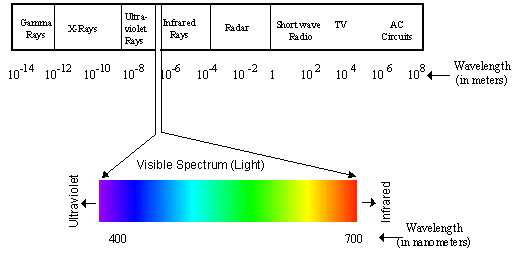I became interested in light and light quality while in high school. Everyone had a set of black light posters in their bedrooms. A black light is actually a lamp that generates ultraviolet light that we cannot see. The light emitted is UVA (400-315 nm) radiation. This is not UVB (315-280 nm), which is harmful. Human normal vision perceives light between 380 and 760 nm. When a black light bulb shines on a poster with fluorescent dyes, it will glow brightly. What you see glowing are phosphors.
Modern laundry detergents contain phosphors that will convert UVA radiation to white light. This is why white T-shirts glow brighter than in normal sunlight. So, don't wear a white shirt when playing laser tag, you will lose (a dirty trick played on me by my teenage sons, I will admit).
But this is not the purpose of this article. Light manufacturers have been designing bulbs for growing plants for as long as we have wanted to grow plants indoors. Lamps include incandescent bulbs, fluorescent tubes, high pressure sodium, metal halide, and mercury vapor bulbs. There have been many advances in bulb design including dual spectra and switchable lamps. New advances in light emitting diodes (LED) are changing the types of lighting we use for plant growth at an exciting rate. (for more information, go to
LED Lighting in Horticulture)

The critical issue when choosing a light source for growing plants is to understand the action spectra plant growth. Plants absorb light primarily in the blue and red wavelengths. Conversely, plants reflect light in the green wavelengths. The challenge for adopting lamps for growing plants indoors has been choosing the right bulb. Most lamp manufacturers report their lamps in terms of color temperature. What we think of as cool colors, blueish white, are at temperatures over 5,000°K and warm colors, yellowish white through red, are at color temperatures between 2,700-3,000°K.
Color and light perception has been long studied and human color perception was first elegantly displayed in 1931 by the Commission Internationale de l'Eclairage (CIE) and advanced in 1978.
 |
| 1931 CIE XYZ Chromaticity Diagram |
 |
| 1978 CIE L*U*V* Chromaticity Diagram |
We can then overlay color temperature onto the CIE diagrams.
Which looks more like this for individual lamps:
Most professional growing operations use high pressure sodium lamps, but this is likely to change in the future as lamp technologies improve. One new technology that we at Colorado State University evaluated was a light emitting plasma lamp or LEP. This lamp was introduced to us by the
Polar-ray company in Boulder, Colo. The LEP lamp was the
Stray Light PlasmaGrow G-1 manufactured by the
Luxim Company. (for the design specifications on the exact lamp we used see:
LiFi-STA-40-02) So we put it to the test.
John Ray, Floriculture Research Associate and Plant and Environmental Research Center Greenhouse Manager, and his practicum students grew four bedding plant species, basil, snapdragon, tomato and zinnia, under two supplemental light sources, high pressure sodium (HPS) and light emitting plasma (LEP). The lamp height between the two were adjusted so that all plants received similar levels of photosynthetic active radiation (PAR). The lamps provided 18 hours of supplemental light in a polycarbonate glazed greenhouse.
The spectral irradiance is displayed on the graph below:
As you can see, the lamps are not similar in spectra, but what is the impact on plant growth? Dry weight data between the four species showed little difference between the two light sources.
Which lamp would you choose? First, you would have to look at price. the LEP lamps are fairly pricey coming it at $1,350 compared to a HPS for around $300. Energy consumption however, may be a different story. The LEP lamp used consumes 273 watts where the HPS lamp used consumes 1,000 watts. So how does one determine efficiency?
Most lamp manufacturers will report their lamp intensity in lumens. Luminous energy is light output in the visible spectra. The luminous energy rating for the LEP lamp was 14,000 lumens and for the HPS lamp, 110,000 lumens. That makes the luminous efficiency for the LEP lamp at 51.3 lumens/watt and the HPS at 110 lumens/watt. But is that relevant?
There are two forms of chlorophyll, chlorophyll a and chlorophyll b. Chlorophyll absorbs the greatest amount of light energy at 430 nm and chlorophyll b absorbs the greatest amount of light energy at 662 nm. There are other carotenoids involved, but that is beyond what we are discussing here.
Which one do you choose? That is strictly up to you.
 So this lone garden chrysanthemum grew well in the flower bed enjoying its southern exposure with filtered shade from my crabapple and plenty of water. I anxiously waited for it to bloom. But wait! Did it mutate over the summer?
So this lone garden chrysanthemum grew well in the flower bed enjoying its southern exposure with filtered shade from my crabapple and plenty of water. I anxiously waited for it to bloom. But wait! Did it mutate over the summer?













